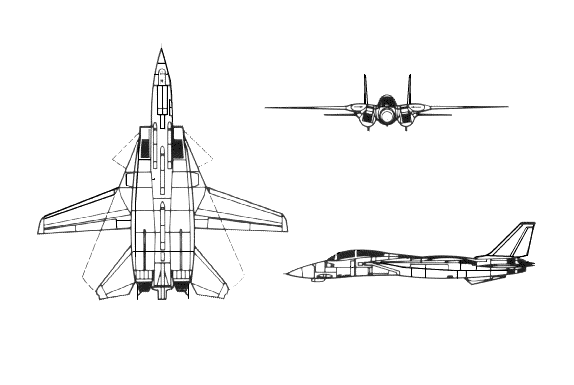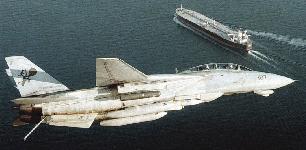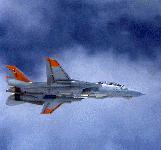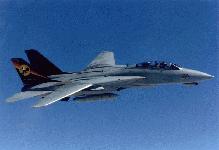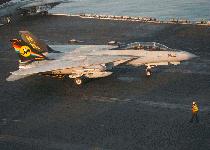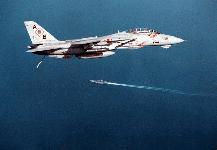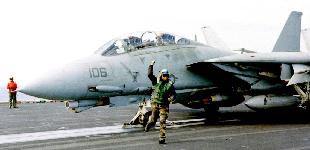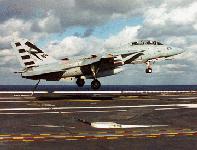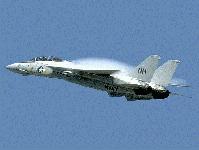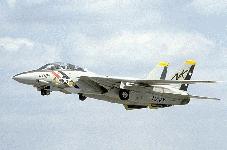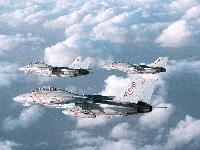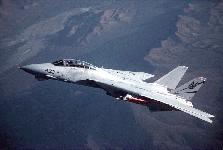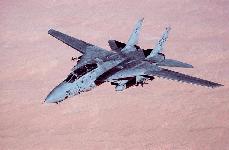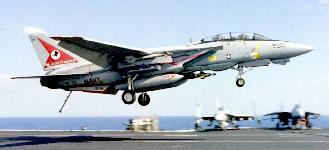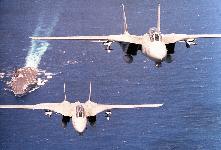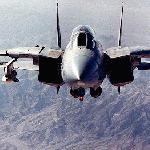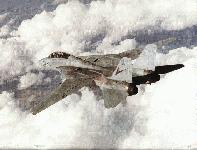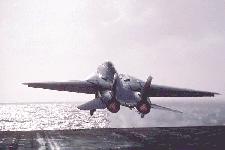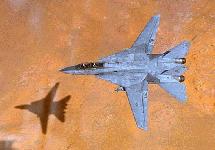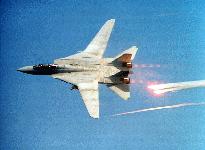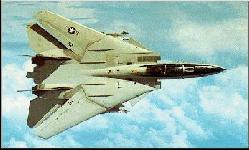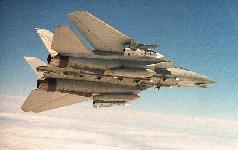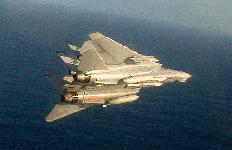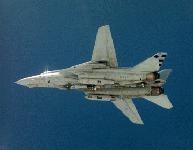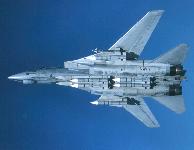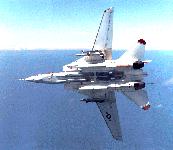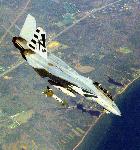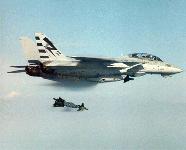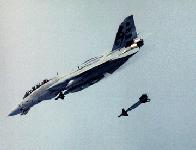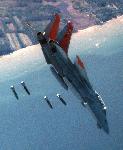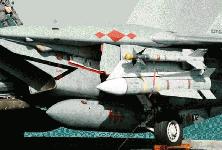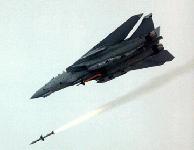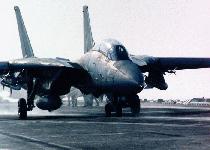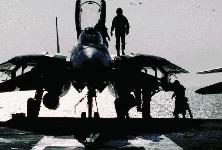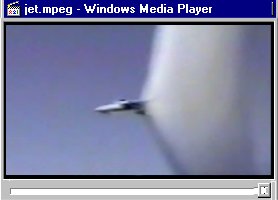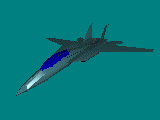
F-14 Tomcat
Wings spread
VRML by Soji Yamakawa
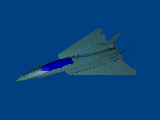
F-14 Tomcat
Wings swept back
VRML by Soji Yamakawa



Following the loss of three aircraft over a four week period in 1996, the CNO ordered a safety stand down to review what was known in order to find out if there were any operational restrictions that needed to be placed on the aircraft. The Navy placed interim restrictions on the F-14 in the low altitude, high speed environment. Afterburner use was prohibited for F-14Bs and F-14Ds at all altitudes except for operational emergencies.
The Grumman F-14, the world's premier air defense fighter, was designed to replace the F-4 Phantom II fighter (phased out in 1986). F-14s provided air cover for the joint strike on Libyan terrorist targets in 1986. The F-14A was introduced in the mid-1970s. The upgraded F-14A+ version, with new General Electric F-110 engines, now widespread throughout the fleet, is more than a match for enemy fighters in close-in, air combat. The AWG-9 is a pulse-Doppler, multi-mode radar with a designed capability to track 24 targets at the same time while simultaneously devising and executing fire control solutions for 6 targets. Designed in the 1960's and one of the oldest air-to-air radar systems, the AWG-9 is still the most powerful and new software will increase its capabilities for the 21st century. The cockpit is fitted with a Kaiser AN/AVG-12 Head-Up Display (HUD) co-located with an AN/AVA-12 vertical situation display and a horizontal situation display. A Northrop AN/AXX-1 Television Camera Set (TCS) is used for visual target identification at long ranges. Mounted on a chin pod, the TCS is a high resolution closed circuit television system with two cockpit selectable Fields Of View (FOV), wide and narrow. The selected FOV is displayed in the cockpit and can be recorded by the Cockpit Television System. A new TCS, in development, will be installed in all three series aircraft. Electronic Support Measures (ESM) equipment include the Litton AN/ALR-45 radar warning and control system, the Magnavox AN/ALR-50 radar warning receiver, Tracor AN/ALE-29/-39 chaff/flare dispensers (fitted in the rear fuselage between the fins), and Sanders AN/ALQ-100 deception jamming pod. The Tomcat has an internal 20-mm Vulcan Gatling-type gun fitted on the left side, and can carry Phoenix, Sparrow, and Sidewinder AAMs. Up to 6 Phoenix missiles can be carried on 4 fuselage stations between the engines and on 2 pylons fitted on the fixed portion of the wing; 2 Sidewinder AAM can be carried on the wing pylons above the Phoenix mount. Although the F-14 was tested with conventional "iron" bombs on its external hardpoints in the 1960s, the BRU-10 ejection racks were not strong enough to provide a clean separation. Tests in 1988-1990 showed that BRU-32 racks could drop Mk 80-series bombs safely. Later tests would qualify the AGM-88 HARM and the AGM-84 Harpoon.Initial operational capability in 1973; first flight on 21 December 1970. 79 Tomcats were delivered to Iran before the 1979 Revolution. They are normally grounded for lack of parts; some were seen flying during December 1989 Iranian maneuvers. The US Navy has 699 in service or on order, with deliveries continuing. (The aircraft was not procured by the US Marine Corps.)
The Navy decided to incorporate the GEC Marconi Digital Flight Control System (DFCS) into all F-14 aircraft to significantly improve flight safety. The system is designed to protect aviators against unrecoverable flat spins and carrier landing mishaps. DFCS also incorporates a lateral stick-to-rudder interconnect designed to improve less than desirable flying qualities in the powered approach configuration. Pilots agree that with the DFCS the Tomcat is more maneuverable and has crisp response to pilot control inputs. The new system should improve performance and safety during carrier landings. This modification affects 211 active duty and 16 reserve F-14 aircraft. The Foreign Comparative Test (FCT) demonstrated that DFCS drastically decreases the chance of entering out-of-control flight and improves the F-14's ability to recover, if a spin is entered. Departure from controlled flight has been a primary causal factor in 35 F-14 mishaps. Also significant is its ability to improve carrier approach line-up control addressing a problem often cited as a contributing factor in carrier landing mishaps. The incorporation of DFCS increases safety, both during "edge-of-the-envelope" maneuvering flight and carrier landings.
The new the Digital Flight Control System [DFCS] provides enhanced maneuverability for the F-14. The DFCS control panel replaces the current AFCS panel in the front cockpit, the analog system in use since the aircraft's inception. It contains the modified SAS switches, and also displays maintenance codes for system failures identified during IBIT and in flight. System (DFCS) that replaced. The DFCS system has lived up to its promise of enhanced controllability and performance in the high AOA regimes and in the landing configuration. However, the structural issue raised by the enhanced roll rates achievable with the DFCS is a potential factor affecting the crucial problem of F-14 fatigue life. During validation of the existing NATOPS rolling G envelope, the primary F-14 test asset sustained extensive structural damage to the starboard engine weekly doors and aft fixed cowl when certain structural limits were exceeded. As it turned out, the problem was not due to DFCS but was related to a NATOPís operational envelope which had not been previously verified. This resulted in the fleet-wide rolling G restrictions from NAVAIR. The impact to the program is going to be felt in an initial envelope for DFCS with reduced rolling g above and beyond the cutbacks for AFCS roll SAS-on, simply because the Navy cannot support any further structural testing until the F-14 test aircraft is repaired. Data is still being analyzed and the restrictions havenít been fully defined yet, but it was anticipated that the initial envelope would still include 6.5 gís symmetric throughout for gross weights of 49.5K or less. For the clean configuration: 4 gís rolling to 570 KCAS, 3 g rolling to 700, and 1 g rolls/no abrupt stick inputs above 700/1.4 For external tanks or Pylon mounted AIM-54s: the "region 3" from NATOPS will begin above 570 KCAS/1.15 TMN at low alt, or 500 KCAS above 25K.In late 1995 the F-14 Tomcat took on a new combat mission as part of Operation Deliberate Force in Bosnia. Nicknammed "Bombcat's", they delivered laser-guided bombs while other aircraft painted the targets with lasers. With the addition of the precision strike mission for F-14 aircrews, there was a shift in the emphasis of training; flight hours now have to be devoted to air-to-ground training as well as for air-to-air training.
Precision Strike provides the F-14 the capability to deliver laser-guided bombs for air-to-ground missions. It consists of the LANTIRN pod with laser designator and internal navigation system, LANTIRN control panel and night vision capable displays. In LANTIRN equipped F-14As and F-14Bs, the TID has been replaced with the PTID. In 1994 the Navy planned to spend over $2.5 billion to add limited ground attack capability and other improvements to 210 F-14 Tomcat fighter aircraft (53 F-14Ds, 81 F-14Bs, and 76 F-14As). The ground attack capabilities were required to partially compensate for the loss in combat capabilities during the period starting in 1997, when all of its A-6E Intruder attack aircraft were retired, to the turn of the century when the F/A-18E/F, the next generation strike fighter, was scheduled to arrive. The F-14 is undergoing two upgrades.
The A/B initial upgrade, includes structural modifications to extend the F-14's fatigue life to 7,500 hours, improved defensive capabilities and cockpit displays, and incorporation of digital architecture and mission computers to speed data processing time and add software capacity. Block I adds a LANTIRN Forward-Looking Infrared (FLIR) pod with a built-in laser to designate targets and allow F-14s to independently drop laser guided bombs (LGBs), a modified cockpit for night attack operations (night vision devices and compatible lighting), and enhanced defensive countermeasures. The A/B upgrade had to be incorporated into 157 F-14 aircraft before the Block I upgrade could be added.Concerned about the Navy's capability to maintain carrier-based power projection without A-6Es and with only limited F-14 upgrades, the Joint Conference Committee on the fiscal year 1994 Defense Authorization Act directed the Navy to add an F-15E equivalent capability to its F-14D aircraft, including the capability to use modern air-to-ground stand-off weapons. But the Navy, in a report submitted on May 20, 1994 outlining its plans for the F-14, reiterated the intent to add only the A/B and Block I upgrades. The Navy estimated it would cost $1.8 billion to add F-15E-equivalent capability to 53 F-14Ds and another $9 billion to upgrade 198 F-14A/Bs. According to the Navy, an upgrade of that magnitude was not affordable. Upgraded F-14s generally have greater range than the F/A-18C and could possibly reach targets beyond the Hornet's range. But planned upgrades will not include an air-to-ground radar for precision ground mapping that would permit crews to locate, identify, and attack targets in adverse weather and poor visibility. In addition, no F-14s will be able to launch current or planned precision munitions or stand-off weapons, except for LGBs.
The 157 F-14A/B models' AWG-9 radar is one of the most powerful US military aircraft radars for detecting multiple air targets approaching at long range, but it does not provide a ground mapping capability that permits crews to locate and attack targets in adverse weather and poor visibility or to precisely update the aircraft's location relative to targets during the approach, a capability that improves bombing accuracy. Only the 53 F-14Ds, with their improved APG-71 synthetic aperture ground mapping radar, will have this capability.
The Block I upgrade does not add any weapon capability new to the F-14, except the ability to independently drop LGBs. No Block I F-14s can launch precision stand-off attack weapons such as the High-speed Anti-Radiation Missile (HARM), Harpoon antiship missile, Maverick
anti-armor missile, Walleye guided bomb, and Stand-off Land Attack Missile (SLAM). Block I aircraft will not be able to employ future precision stand-off weapons, including the Joint Direct Attack Munition (JDAM) and the Joint Stand Off Weapon (JSOW). The Navy does plan to add the capability to launch the Advanced Medium Range Air-to-Air Missile (AMRAAM) to F-14Ds when their computer software is updated.
Specifications | |
| Function | Carrier-based multi-role strike fighter |
| Contractor | Grumman Aerospace Corporation |
| Unit Cost | $38 million |
| Propulsion |
F-14: two Pratt & Whitney TF-30P-414A turbofan engines with afterburners; F-14B and F-14D: two General Electric F-110-GE-400 augmented turbofan engines with afterburners |
| Thrust |
F-14A: 20,900 pounds (9,405 kg) static thrust per engine; F-14B and F-14D: 27,000 pounds (12,150 kg) per engine |
| Length | 61 feet 9 inches (18.6 meters) |
| Height | 16 feet (4.8 meters) |
| Maximum Takeoff Weight | 72,900 pounds (32,805 kg) |
| Wingspan | 64 feet (19 meters) unswept, 38 feet (11.4 meters) swept |
| Ceiling | Above 53,000 feet |
| Speed |
Max Mach Number = 1.88 Cruise Mach Number = .72 Carrier Approach Speed = 125 kts |
| Mission Radius |
500 nm Hi-Med-Hi strike profile 380 nm Hi-Lo-Lo-Hi strike profile |
| Crew | Two: pilot and radar intercept officer |
| Armament | Up to 13,000 pounds of
Air-to-Air Missiles (up to) 6 AIM-7 Sparrows 4 AIM-9 Sidewinder 6 AIM-54 Phoenix air-to-ground ordnance MK-82 (500 lbs.) 4 MK-83 (1,000 lbs.) 4 MK-84 (2,000 lbs.) MK-20 cluster bomb 4 GBU-10 LGB GBU-12 MK-82 LGB 4 GBU-16 MK-83 LGB 4 GBU-24 MK-84 LGB one MK-61A1 Vulcan 20mm cannon
Selected F-14A and B are wired to carry TARPS |
| Countermeasures |
|
| Date Deployed | |
| First flight | December 1970 |
| Inventory |
157 F-14A/B 53 F-14D Phasing out one squadron / year All to be withdrawn by 2010
F-14 orginally designed for 6,000 flight hours |
| VRML 3-D Model | |
 F-14 Tomcat Wings spread VRML by Soji Yamakawa |
 F-14 Tomcat Wings swept back VRML by Soji Yamakawa |
